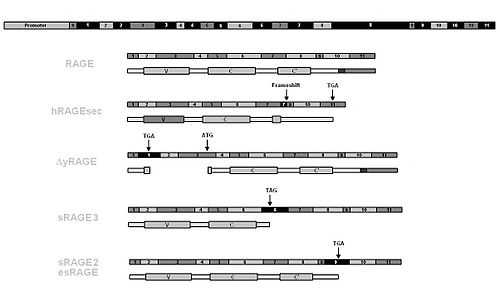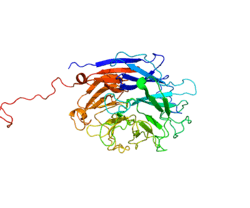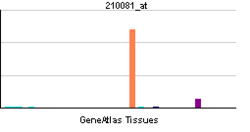RAGE (receptor)


RAGE, the receptor for advanced glycation endproducts is a 35 kDa transmembrane receptor of the immunoglobulin super family which was first characterized in 1992 by Neeper et al.[1] It is also called "AGER". Its name comes from its ability to bind advanced glycation endproducts (AGE), which include chiefly glycoproteins, the glycans of which have been modified non-enzymatically through the Maillard reaction. In view of its inflammatory function in innate immunity and its ability to detect a class of ligands through a common motif, RAGE is often referred to as a pattern recognition receptor. RAGE also has at least one other agonistic ligand: high mobility group protein B1 (HMGB1). HMGB1 is an intracellular DNA-binding protein important in chromatin remodeling which can be released by necrotic cells passively and by active secretion from macrophages, natural killer (NK) cells and dendritic cells.
The interaction between RAGE and its ligands is thought to result in pro-inflammatory gene activation.[2] Due to an enhanced level of RAGE ligands in diabetes or other chronic disorders, this receptor is hypothesised to have a causative effect in a range of inflammatory diseases such as diabetic complications, Alzheimer's disease and even some tumors.
Isoforms of the RAGE protein, which lack the transmembrane and the signaling domain (commonly referred to as soluble RAGE or sRAGE) are hypothesized to counteract the detrimental action of the full-length receptor and are hoped to provide a means to develop a cure against RAGE-associated diseases.
Gene and polymorphisms
The human RAGE gene lies within the major histocompatibility complex (MHC) class III region on chromosome 6 and comprises 11 exons interlaced by 10 introns. Total length of the gene is about 1400 base pairs (bp) including the promoter region, which partly overlaps with the PBX2 gene.[3] About 30 polymorphisms are known most of which are single nucleotide polymorphisms (SNP).[4]
RNA and alternative splicing
The primary transcript of the human RAGE gene (pre-mRNA) is thought to be alternatively spliced. So far about 6 isoforms including the full length transmembrane receptor have been found in different tissues such as lung, kidney, brain etc. Five of these 6 isoforms lack the transmembrane domain and are thus believed to be secreted from cells. Generally these isoforms are referred to as sRAGE (soluble RAGE) or esRAGE (endogenous secretory RAGE). One of the isoforms lacks the V-domain and is thus believed not to be able to bind RAGE ligands.
Structure
The full receptor consists of 5 domains: The cytosolic domain, which is responsible for signal transduction, the transmembrane domain which anchors the receptor in the cell membrane, the variable domain which binds the RAGE ligands, and two constant domains.
Ligands
RAGE is able to bind several ligands and therefore is referred to as a pattern-recognition receptor. Ligands which have so far been found to bind RAGE are:
- AGE
- HMGB1 (Amphoterin)
- S100B
- S100A7 (psoriasin) but not highly homologous S100A15 (koebnerisin)
- S100P
- Amyloid-β-protein
- Mac-1
- Phosphatidylserine.
RAGE and disease
RAGE has been linked to several chronic diseases, which are thought to result from vascular damage. The pathogenesis is hypothesized to include ligand binding, upon which RAGE signals activation of nuclear factor kappa B (NF-κB). NF-κB controls several genes involved in inflammation. RAGE itself is upregulated by NF-κB. Given a condition in which there is a large amount of RAGE ligands (e.g. AGE in diabetes or amyloid-β-protein in Alzheimer's disease) this establishes a positive feed-back cycle, which leads to chronic inflammation. This chronic condition is then believed to alter the micro- and macrovasculature, resulting in organ damage or even organ failure. Diseases that have been linked to RAGE are:
- Atherosclerosis
- Peripheral vascular disease
- Myocardial infarction
- Congestive heart failure
- Diabetic retinopathy
- Diabetic neuropathy
- Diabetic nephropathy
- Alzheimer's disease
- Psoriasis
- Takayasu's arteritis[5]
AGE receptors
Besides RAGE there are other receptors which are believed to bind advanced glycation endproducts. However, these receptors could play a role in removal of AGE rather than in signal transduction as it is the case for RAGE. Other AGE receptors are:
- SR-A (Macrophage scavenger receptor Type I and II)
- OST-48 (Oligosaccharyl transferase-4) (AGE-R1)
- 80 K-H phosphoprotein (Proteinkinase C substrate) (AGE-R2)
- Galectin-3 (AGE-R3)
- LOX-1 (Lectin-like oxidized low density lipoprotein receptor-1)
- CD36
References
- ↑ Neeper M, Schmidt AM, Brett J, Yan SD, Wang F, Pan YC, Elliston K, Stern D, Shaw A (July 1992). "Cloning and expression of a cell surface receptor for advanced glycosylation end products of proteins". J. Biol. Chem. 267 (21): 14998–5004. PMID 1378843.
- ↑ Bierhaus A, Schiekofer S, Schwaninger M, Andrassy M, Humpert PM, Chen J, Hong M, Luther T, Henle T, Klöting I, Morcos M, Hofmann M, Tritschler H, Weigle B, Kasper M, Smith M, Perry G, Schmidt AM, Stern DM, Häring HU, Schleicher E, Nawroth PP (December 2001). "Diabetes-associated sustained activation of the transcription factor nuclear factor-kappaB". Diabetes 50 (12): 2792–808. doi:10.2337/diabetes.50.12.2792. PMID 11723063.
- ↑ Hudson BI, Stickland MH, Futers TS, Grant PJ (June 2001). "Effects of novel polymorphisms in the RAGE gene on transcriptional regulation and their association with diabetic retinopathy". Diabetes 50 (6): 1505–11. doi:10.2337/diabetes.50.6.1505. PMID 11375354.
- ↑ Hudson BI, Hofman MA, Bucciarelli L et al. (2002). "Glycation and diabetes: The RAGE connection" (PDF). Current Science 83 (12): 1515–1521.
- ↑ Mahajan N, Mahmood S, Jain S, Dhawan V (September 2013). "Receptor for advanced glycation end products (RAGE), inflammatory ligand EN-RAGE and soluble RAGE (sRAGE) in subjects with Takayasu's arteritis". Int J Cardiology 168 (1): 532–34. doi:10.1016/j.ijcard.2013.01.002. PMID 23398829.
Further reading
- Naka Y, Bucciarelli LG, Wendt T et al. (2005). "RAGE axis: Animal models and novel insights into the vascular complications of diabetes.". Arterioscler. Thromb. Vasc. Biol. 24 (8): 1342–9. doi:10.1161/01.ATV.0000133191.71196.90. PMID 15155381.
- Simm A, Bartling B, Silber RE (2004). "RAGE: a new pleiotropic antagonistic gene?". Ann. N. Y. Acad. Sci. 1019: 228–31. doi:10.1196/annals.1297.038. PMID 15247020.
- Nawroth P, Bierhaus A, Marrero M et al. (2005). "Atherosclerosis and restenosis: is there a role for RAGE?". Curr. Diab. Rep. 5 (1): 11–6. doi:10.1007/s11892-005-0061-9. PMID 15663911.
External links
- RAGE receptor at the US National Library of Medicine Medical Subject Headings (MeSH)
- AGER on the Atlas of Genetics and Oncology


